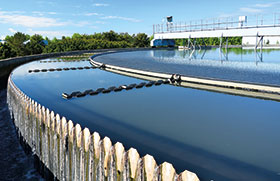

Tampere Water recently installed several Valmet total solids measurement devices and a sludge dewatering control package at its Viinikanlahti wastewater treatment plant in Tampere, Finland.
After the start-up at Viinikanlahti, immediate results were visible, from savings in pumping energy to improved anaerobic digestion and subsequent sludge dewatering. In addition to improved solids control, the measurements now also provide a valuable insight to plant operation, with real-time solids information replacing infrequent laboratory analysis. Maintenance engineer, Ari Oksanen comments: “We can now see process parameters in kilos rather than cubic meters, which is a great help in optimising the different stages of treatment.”
Although the highly efficient treatment methods meet the requirements of Finnish and European Union legislation, Tampere Water decided in 2015 to enlist Valmet’s help to improve its chemical and energy efficiency. Heikki Syrjälä, technical manager at Tampere Water, valued Valmet’s input to the project. “As we are planning a new treatment plant, this was a good opportunity to discover what the latest technology has to offer,” he says.
Total solids measurement
Three Valmet total solids transmitters (Valmet TS) are in use to measure total solids after the primary clarifiers, before the digester and before the dewatering centrifuge. The four circular primary clarifiers allow solids in the wastewater to settle to the bottom of the clarifier before being pumped to the sludge thickening tank. Prior to the Valmet TS installation, pumping from the four clarifiers was controlled in a timed sequence, which meant that from time to time a clarifier would be emptied of solids and only water would be pumped to the thickening tank. With Valmet TS measuring the total solids content, the pumping sequence from the four clarifiers is now controlled to a minimum solids content, avoiding excess water being pumped to sludge thickening. According to Sami Ilomäki, operating engineer, the reduction in pumping has been quite dramatic: “We used to pump 76 m3 an hour to thickening. Now, with accurate total solids control, that’s fallen to only 50 m3 an hour, saving pumping energy and reducing excess water to thickening.” With a second Valmet TS transmitter after thickening, the measured solids content to the digester has now increased from 3,5% to 5%. “The higher solids content in the digester reduces the heating demand and has also resulted in less foam,” says Ilomäki. As well as needing less heat, the optimised solids content also increases digester residence time, producing more biogas.
Centrifuge control
After anaerobic digestion, the sludge is de-watered before being transported by truck for use in agriculture, landscaping and other soil improvement uses. Sludge dewatering is carried out in the centrifuge, where water is forced from the sludge. The dried sludge (dry cake) is then taken by conveyor to be trucked away from the plant. The liquid centrate from the centrifuge is recycled back into the process. As Syrjälä explains: “Sludge dewatering is a complicated process using both energy and chemicals. To avoid wasting either of them and to save on transportation costs, optimisation is necessary. Running the process manually in the optimal way is difficult.”
Optimisation of sludge dewatering
The Valmet solution is dewatering optimisation with the Valmet Sludge Dewatering Optimiser (SDO) control package. Valmet SDO is a small-scale Valmet DNA control system employing multi-variable model predictive control (MPC) to control the centrifuge operation. A Valmet TS transmitter is used to stabilise the mass flow to the centrifuge, now measured in kilos of sludge per hour. The first phase of optimisation performed in December 2015 allowed dewatering polymer to be controlled as a ratio to the mass flow, rather than the cubic meter-based flow rate previously used. With the mass flow under control, the second phase of optimisation in January 2016 was to optimise solids in the centrate and moisture in the dry cake with a combination of torque control and polymer.
A Valmet Low Solids Measurement (Valmet LS) is installed in the centrate outflow and another specialised measurement, Valmet DS, measures the solid content of the dry cake as it falls to the conveyor. This is where the multivariable model predictive control, unique to Valmet SDO, comes into play. As the centrifuge torque is increased, more water is extracted from the sludge and the solid content increases in the dried sludge, but at the same time centrate solids increase to be wastefully re-circulated through the plant. Increasing polymer dosage increases the solid content of the dried sludge and also reduces centrate solids, so the control combines the optimum torque and correct polymer dosage to save both energy and chemicals while achieving the optimum amount of reject solids and a higher dryness in the dry cake from the centrifuge.
More good results
The new measurements and centrifuge dewatering control have been very successful, Sami Ilomäki reports: “Previously, our centrifuge operating parameters had to be very much on the safe side to limit the recirculation of reject (centrate) solids. We have now been able to reduce reject solids by 50%.” Ilomäki sees room for even further improvement as people become more familiar with the controls: “The controls are easy to operate and the system is very user friendly, allowing us to easily adjust parameters and even measure the effectiveness of different polymers. We now have a much better picture of what is going on in the treatment process.”
For more information contact Hugh Heine, Valmet, +27 (0)31 539 8640, [email protected], www.valmet.com
| Tel: | +27 31 539 8640 |
| Email: | [email protected] |
| www: | www.valmet.com |
| Articles: | More information and articles about Valmet Automation |
© Technews Publishing (Pty) Ltd | All Rights Reserved